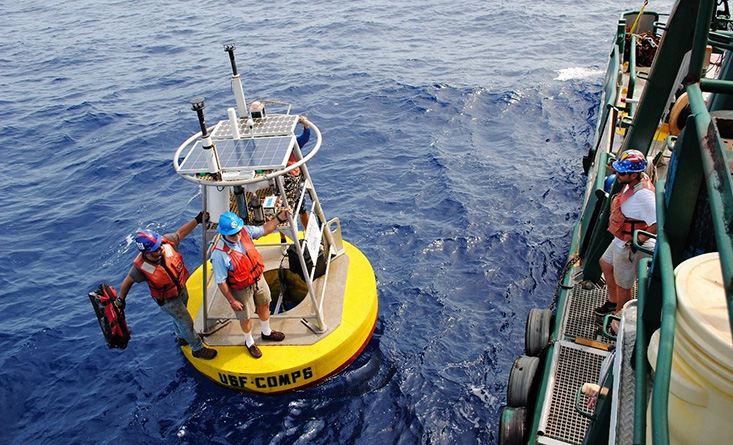By Sean Beckwith, PhD student
ST. PETERSBURG, FL – Leaving Tampa Bay, as the color of the Gulf of Mexico transitioned from brown to green to brilliant blue, I was reminded of what it feels like to be ‘out to sea.’
Senses are awakened by the lack of visible land in any direction. The ship sways with the rhythm of offshore swells. Flying fish glide in schools across the surface of the waves. The air is fresh…not salty, or fishy, as one might casually suspect of a spot surrounded by ocean.
Last week, I boarded the Florida Institute of Oceanography’s R/V Weatherbird II with members of the USF College of Marine Science’s (CMS) Ocean Circulation Lab (OCL) as we steamed to the Dry Tortugas. The crew and scientific party worked long days to deploy two buoys and a bottom-mount device and recover a buoy needing annual maintenance. The cruise, titled COMPS-89, was conducted in support of the mission of the Coastal Ocean Monitoring and Prediction System (COMPS).
Joining a COMPS cruise was not only a learning experience in terms of refreshing my (limited) knowledge of physical oceanography, but it was also an opportunity to see some pretty awesome scientists in action.
Bob Weisberg, Distinguished University Professor of Physical Oceanography, is a storied researcher and contributor in his field, and Jay Law, Mooring Technician and Research Associate in Dr. Weisberg’s lab, is, in my mind, the classic example of an oceanographer at sea – slinging ropes and chains around on the back deck of a research vessel, fiddling with instrumentation, jumping on buoys, diving to depths. Jay does it all. And, in addition, his efforts over the years to educate and to provide transferrable skills to younger students has led to a fairly robust intern program within the OCL.
Sebastian DiGeronimo is a prime example of the kind of skilled technician cultivated in the OCL intern program. He was awarded a competitive UNOLS MATE paid internship for 2019, which he had completed at the University of Delaware before returning to St. Petersburg, just a day ahead of departing on the R/V Weatherbird II for the COMPS-89 cruise.
DiGeronimo works with Law in the laboratory and other marine facilities on the Bayboro peninsula to prep instruments and buoys for deployment. His time at sea is his time to shine, assisting Law and others during buoy deployments and water samplings.
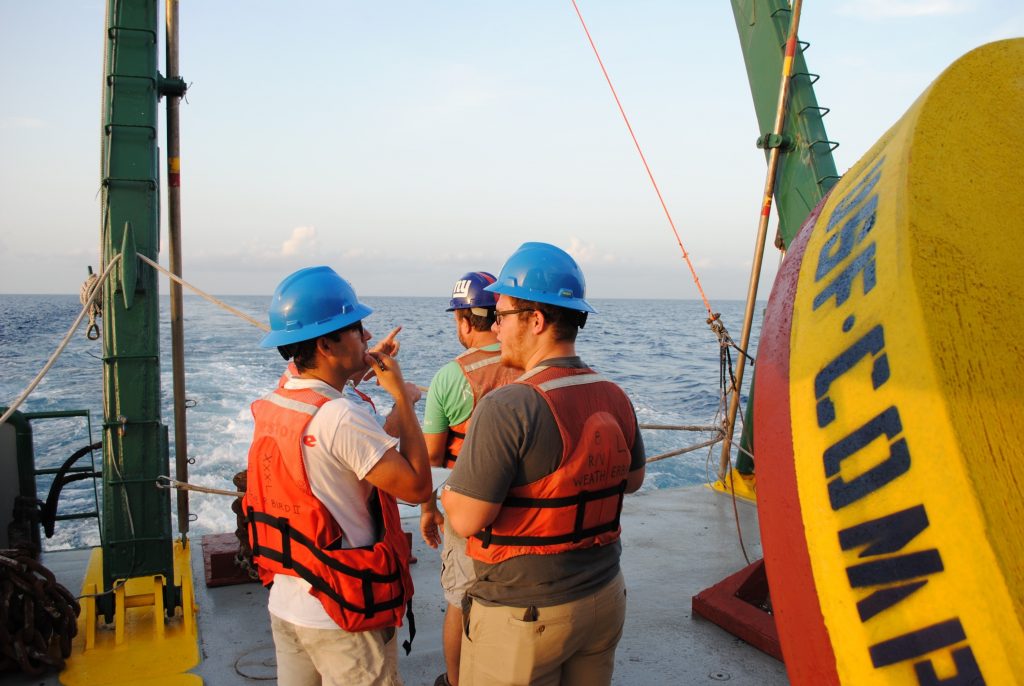
Luis Sorinas Morales (left) discusses operations with Sebastian DiGeronimo (right) before deploying a buoy.
Weisberg kept more than busy himself, lending a hand with the dirty work on the deck
of the Weatherbird II as he dragged chains and pulled ropes throughout the deployments.
Between rounds of labor, Weisberg took time to explain some of the physical oceanographic
principles related to the buoys distributed on the west Florida shelf and the reason
for their strategic locations.
Most of the buoys employed by the OCL are found roughly along the middle of the expansive shelf that extends well over a hundred miles from the Florida coast out into the Gulf of Mexico before coming to an abrupt edge at the Florida Escarpment, a carbonate cliff that plummets thousands of meters into the abyss of the central Gulf of Mexico.
The buoys, in particular C-12, C-13, and C-22 (a buoy reintroduced on this cruise to a location that had not been occupied for some time), allow Weisberg and fellow researchers to understand the circulation of the waters in the Eastern Gulf of Mexico, including the all-important Loop Current, an ocean current that dictates much of what goes into and comes out of the Gulf. As the Loop Current travels clockwise through a portion of the Gulf of Mexico, it transports warm oceanic seawater while also causing upwelling, the process by which surface water traveling away from shore (from the continent) creates vertical circulation that draws deeper, colder water up to the coast, bringing nutrients with it.
Studying the upwelling created by the Loop Current is also important for understanding and making better predictions of red tide. Measurements of chlorophyll, as well as water samples collected from CTD casts, provide a clearer picture of the bottom waters and will hopefully allow researchers to create a more accurate red tide forecast for this year.
Luis Sorinas Morales, a Ph.D. student in Weisberg’s lab, took the lead in water sample collection for the cruise, teaching others on board the proper method for filling the bottles. Sorinas was tasked with gathering water samples for labs who could not send participants on the cruise. In addition to collecting samples for FWC FWRI’s Harmful Algal Bloom group (for red tide analysis), Sorinas collected a separate set of water samples for another lab at the College of Marine Science, led by Dr. Kristen Buck, who will examine the water samples for trace metals.
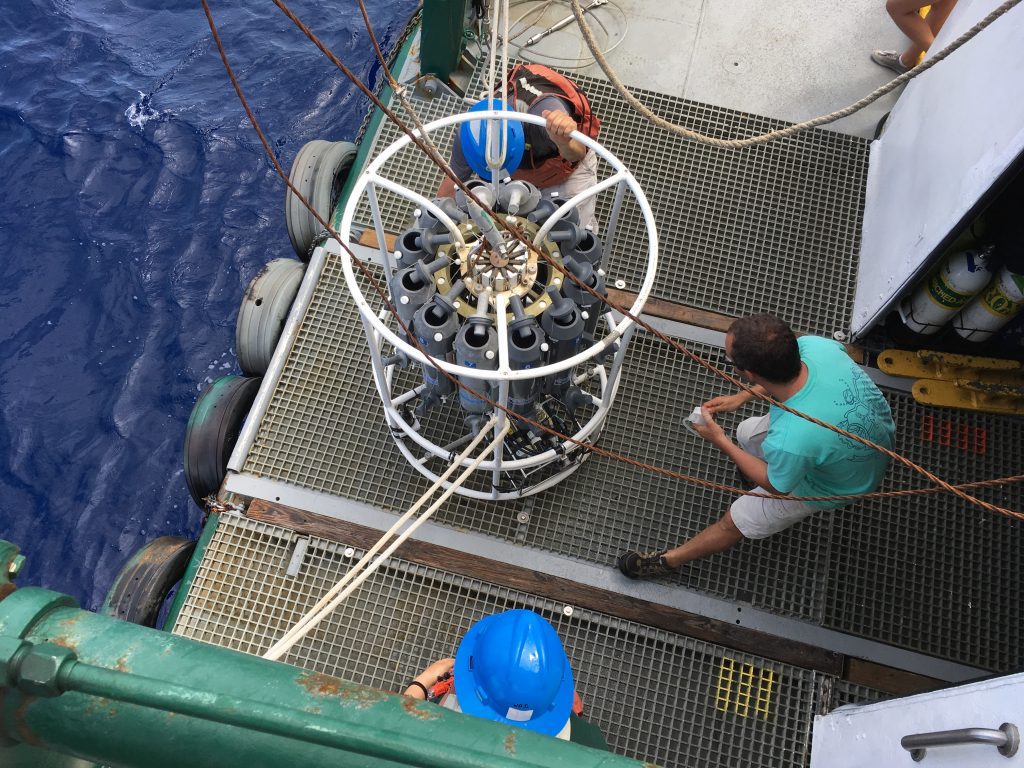
Luis Sorinas Morales examines the Niskin bottles on the rosette ahead of a CTD cast and water sampling.
Assisting with the water sampling effort was Abby Blackburn, a USFSP student who has been one of Law’s go-to interns for cruises over the past year.
A very capable technician – working the buoy deployments on the back deck of the Weatherbird
II, assisting the crew on CTD casts (which measure conductivity, temperature, and
depth), and collecting water samples – Blackburn also revealed her knowledge of marine
species as we examined some of the underwater footage taken during scientific proficiency
dives.
Naming off fish, invertebrates, corals and more as we sat around the ship’s galley during a break, Blackburn added some clarity to the list of organisms I had described on my dive tablet as “yellow tube-like fish,” “blue oval-shaped kind-of-big fish,” “silvery small fish in group…,” etc.
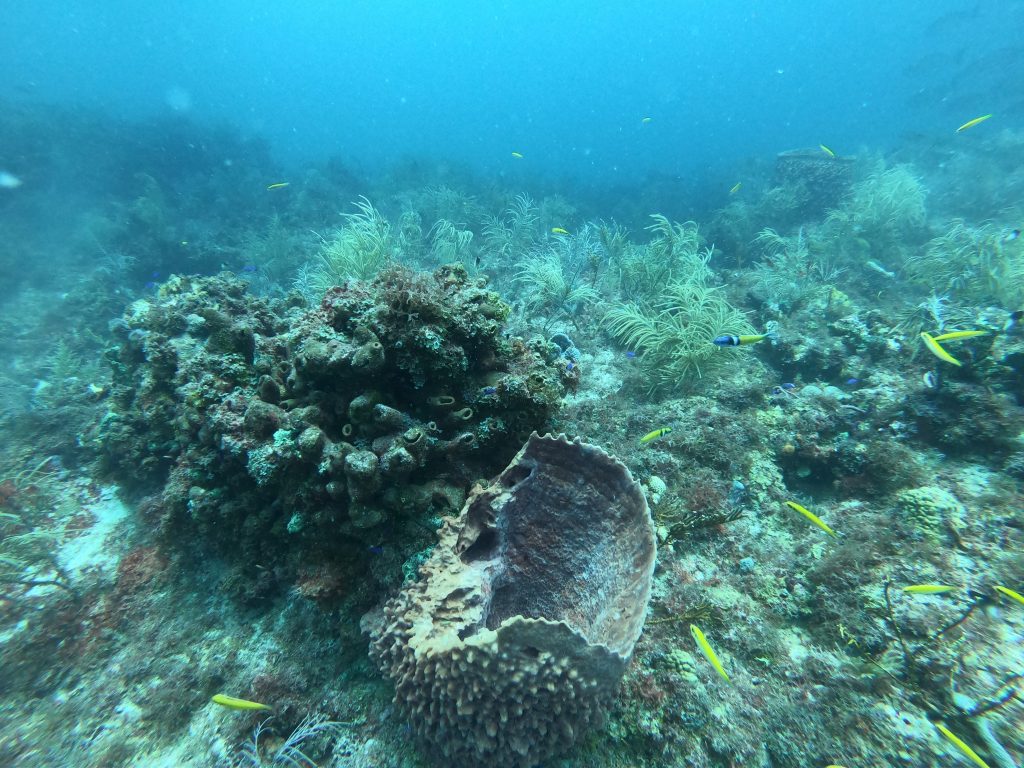
A glimpe of the spectacular life found on Tortugas Bank in the Dry Tortugas National Park.
With all available bunk space taken, it was a full house on board the cruise. A true
win-win situation: Weisberg’s group was aided by the additional hands, and the interns
and volunteers on board were rewarded with a learning experience. From the USFSP
program for Environmental Science and Policy, Geography and Sustainability, Alexandria McPhail and Andrea Rodriguez Campos joined the cruise as interns, helping
out with water collection and logging information while observing the work of the
crew and scientists during buoy and instrument deployments.
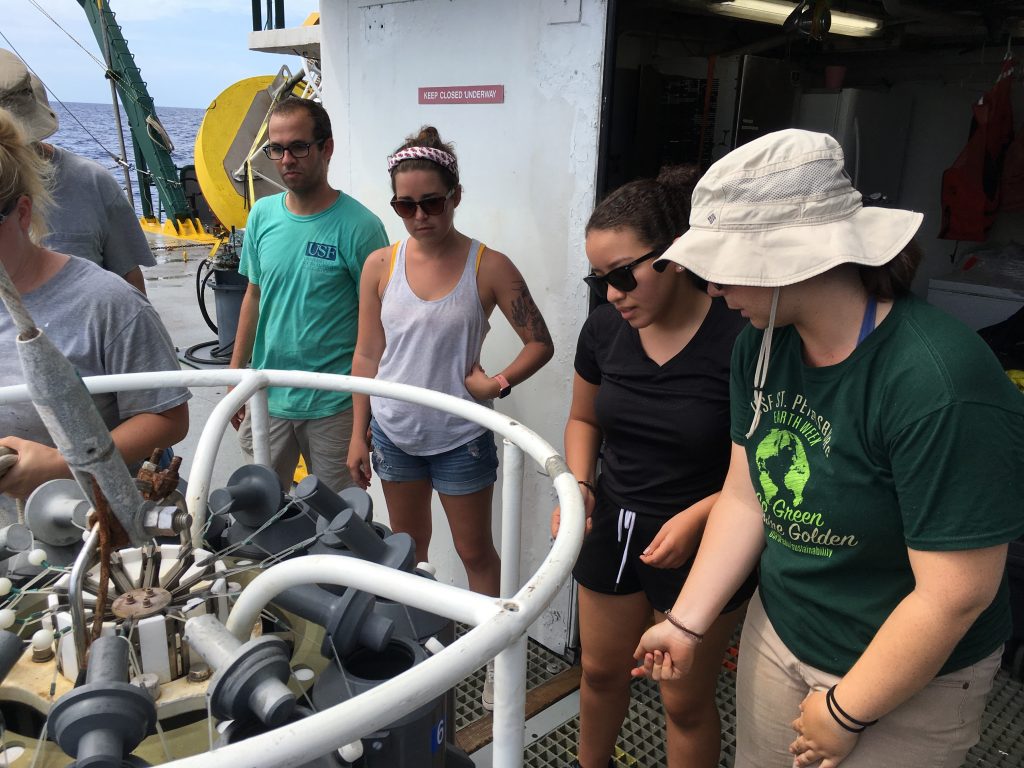
Abby Blackburn (right) explains the water sampling procedures to fellow interns Andrea Rodriguez Campos and Alexandria McPhail (2nd and 3rd from right, respectively).
From the Tampa campus, an undergraduate in Environmental Science, William “Hunter”
Ely, and a graduate student of Environmental Engineering, Talon Bullard, joined as
observers and divers. Ely and Bullard found out about the cruise opportunity through
USF Dive Safety Officer, Ben Meister, who, in addition to supporting the dive operations,
also took time to coach interns learning the ropes of working at sea.
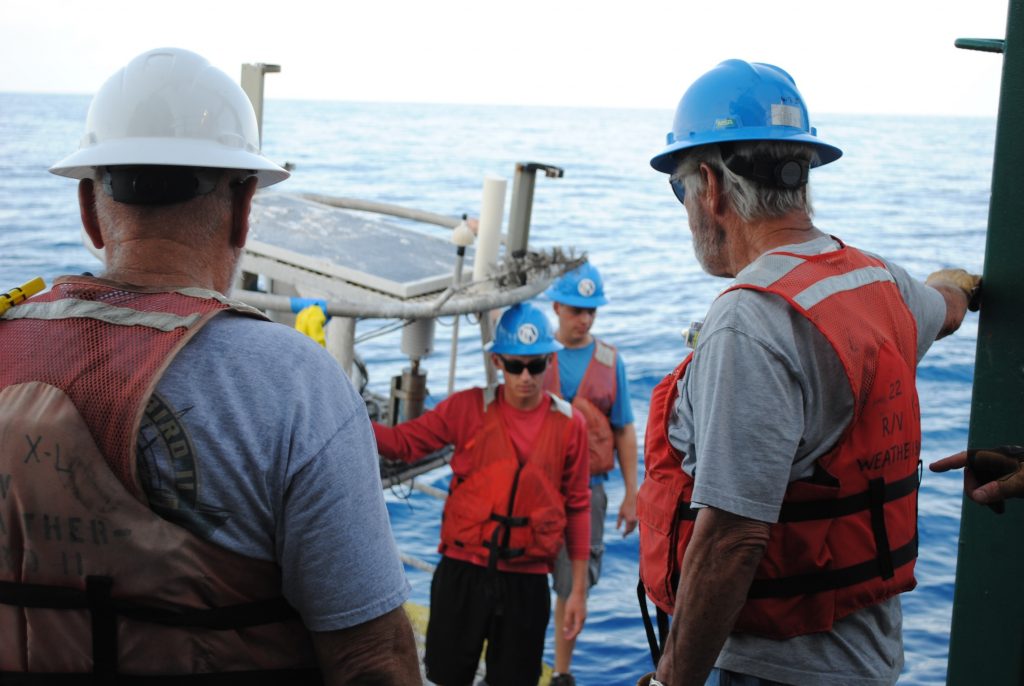
William Ely (buoy, foreground) and Talon Bullard (buoy, background) prepare to reboard the Weatherbird II after a trip on a newly deployed buoy.
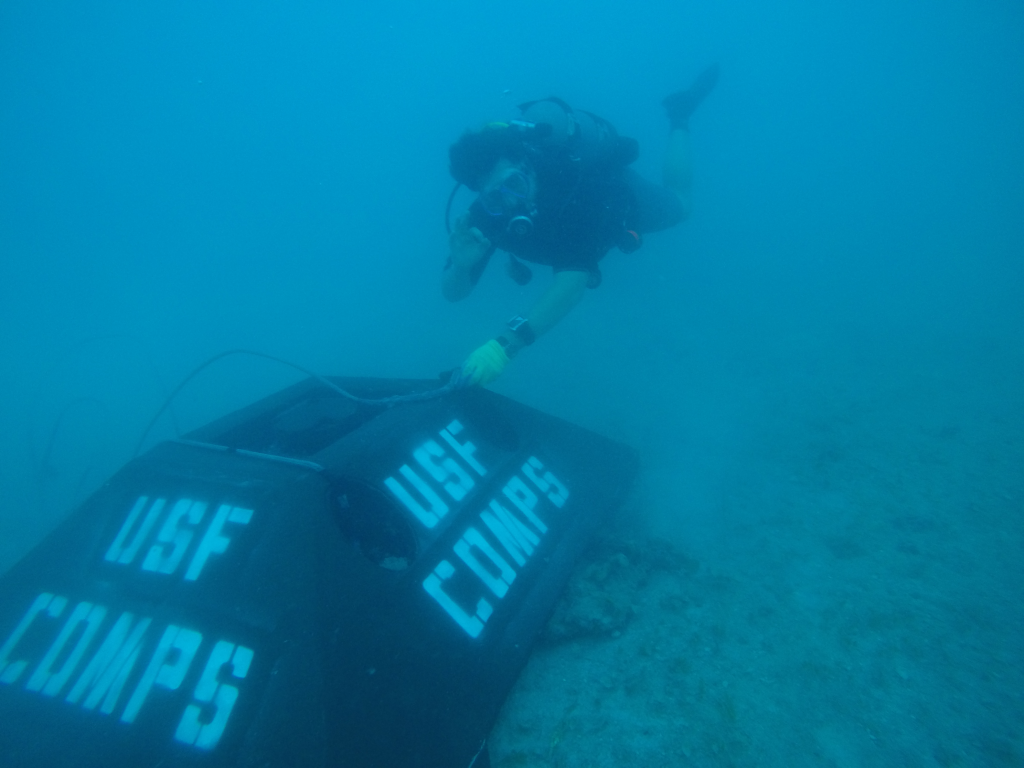
Ben Meister detaches a lifting harness from an acoustic Doppler current profiler bottom mount in Rebecca Shoals. Photo: Jay Law
The list of team players continues – and, as a side note, this cruise was a perfect
success largely due to how well everyone on board worked together. Everyone demonstrated
humility and eagerly assisted when able. Dennis Mayer, Data Analyst and Oceanographer
with the Ocean Circulation Lab, joined as a volunteer, and ultimately, as an additional teacher, who explained,
in common terms, some of the fundamental concepts employed by Weisberg in projects
of the OCL.
Ian Williams, a graduate student in Dr. Ernst Peebles lab at CMS, also joined as a volunteer, taking part in the dives and serving as safety diver on board the ship while the other dive team was underwater.
Randy Russel, lead electronics engineer with the CMS Ocean Technology Group, is a core player in CMS oceanographic operations, connecting scientific ingenuity to real-world applications. Russel spent much of the 4-day cruise in the ship’s lab, stationed in front of his computers, checking the satellite feed and validating the performance of the instruments that had been deployed from the deck of the ship.
Smooth seas and generally good weather did not hurt at all, in terms of helping operations to go smoothly and efficiently throughout the 4-day trip aboard the Weatherbird II. From the weather to the locations to the hard work supporting scientific missions, it was, all-around, a great cruise. Thank you to the well-wishers who hoped for ‘fair winds and following seas.’ Indeed we had both.
